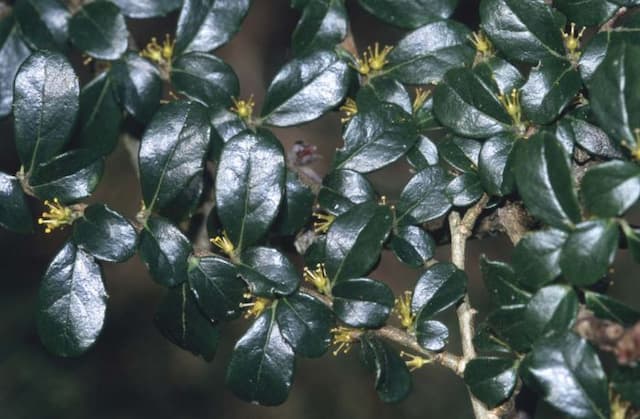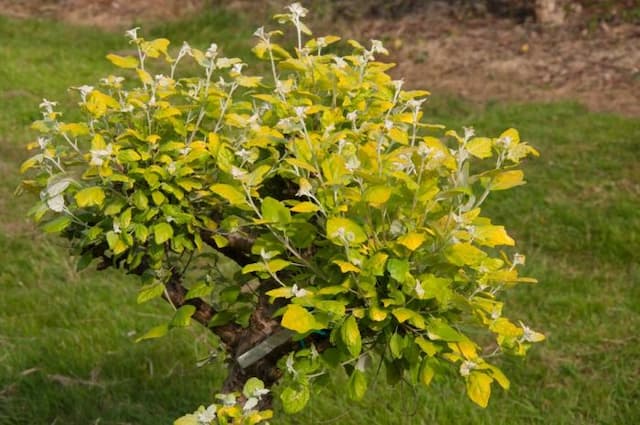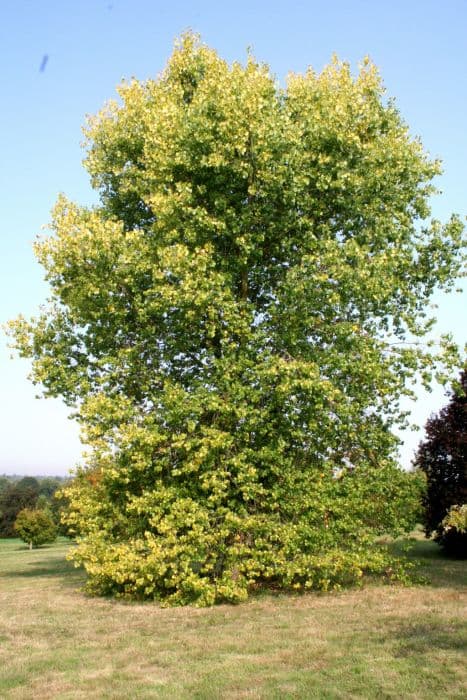Boyd's Willow Salix 'Boydii' (f)

ABOUT
Salix 'Boydii', commonly known as the dwarf willow, presents a compact and rounded form, creating an appearance that is both lush and delicate. The plant is characterized by its fine branching and small, soft, silvery-green leaves. During the growing season, these leaves commonly take on a slightly fuzzy texture, which adds to the dwarf willow's charm and tactile appeal. The plant's stems display a slender and flexible quality, often with a grayish or brownish bark that provides a subtle contrast against the bright foliage. In spring, the dwarf willow produces yellow catkins, which are small, fluffy, and cylinder-shaped flower clusters that are often sought out by bees and other pollinators. Throughout the seasons, the foliage may change in color, often turning to lovely shades of yellow or gold in the autumn before falling. The overall shape of the plant gives it a soft, mounded look, suitable for a variety of garden settings. Despite its name, the dwarf willow carries the essence of the classic willows: a serene, graceful demeanor that can add beauty to both small garden spaces and larger landscape designs.
About this plant
 Names
NamesFamily
Salicaceae
Synonyms
Boyds Willow
Common names
Salix 'Boydii'
 Toxicity
ToxicityTo humans
Willow (Salix 'Boydii') is not commonly known for its toxicity to humans. Willows, in general, contain salicin, which is a precursor to aspirin. However, consuming parts of the willow in large quantities could potentially cause adverse effects similar to aspirin overdose, such as gastrointestinal upset, nausea, vomiting, or more severe effects like tinnitus, breathing difficulties, or central nervous system effects in very large doses. It's always advisable to avoid ingesting plant material that is not meant for consumption.
To pets
Willow (Salix 'Boydii') is similarly not known to be significantly toxic to pets. Like with humans, the salicin present in willow can lead to effects similar to those of aspirin if consumed in large amounts. Pets ingesting small amounts of willow might experience mild digestive upset whereas larger amounts could potentially cause more serious symptoms such as vomiting, diarrhea, or even salicylate toxicity, characterized by issues like changes in blood acidity, abnormal breathing, and central nervous system effects in severe cases. It is best to prevent pets from eating ornamental plants due to possible sensitivities or unexpected reactions.
 Characteristics
CharacteristicsLife cycle
Perennials
Foliage type
Deciduous
Color of leaves
Green
Height
3 feet (0.91 meters)
Spread
3 feet (0.91 meters)
Plant type
Shrub
Hardiness zones
5
Native area
Europe
Benefits
 General Benefits
General Benefits- Ornamental value: The Salix 'Boydii', commonly known as Dwarf Willow, has a distinctive and attractive growth habit that can enhance the aesthetic appeal of gardens and landscapes.
- Low maintenance: Dwarf Willow is a hardy plant that generally requires minimal care once established, making it an ideal choice for gardeners of all skill levels.
- Erosion control: The spreading roots of Dwarf Willow help stabilize soil and prevent erosion, especially in riparian zones or areas with loose soil.
- Wildlife habitat: It provides shelter and nesting sites for birds and can attract beneficial insects to the garden.
- Fast growth: Dwarf Willow is known for its quick growth rate, allowing for rapid establishment and covering of bare spots in the landscape.
- Soil improvement: As it sheds leaves and branches, the plant contributes to soil organic matter, improving soil quality over time.
- Tolerance of wet conditions: Dwarf Willow thrives in moist and even boggy soil conditions, making it suitable for planting in challenging wet areas where other plants might fail.
 Medical Properties
Medical PropertiesThis plant is not used for medical purposes.
 Air-purifying Qualities
Air-purifying QualitiesThis plant is not specifically known for air purifying qualities.
 Other Uses
Other Uses- Miniature Bonsai - Salix 'Boydii' can be cultivated as a miniature bonsai, offering enthusiasts a chance to work with a willow species for this ancient Japanese art.
- Artistic Inspiration - Artists may use the intricate forms and patterns in the bark and branches of the dwarf willow as inspiration for drawings, paintings, and sculptures.
- Education and Research - Dwarf willow can be used in educational settings for plant biology studies due to its unique size and growth habits.
- Photography - Its unique miniature stature and visually interesting features make the dwarf willow a great subject for botanical and natural world photographers.
- Erosion Control - Although not as robust as its larger relatives, Salix 'Boydii' can still contribute to erosion control in garden settings where space is limited.
- Wildlife Habitat - The plant provides a micro-habitat or source of food for insects and other small garden fauna.
- Winter Interest - Dwarf willow maintains an interesting silhouette in the garden during the winter, adding visual appeal when other plants have died back.
- Decorative Craft Material - The stems and leaves can be used in decorative crafts, such as wreaths or small arrangements.
- Soil Conditioning - Decaying leaves and stems can contribute to the organic matter in the soil, helping improve its structure and fertility over time.
- Container Gardening - Well suited for container gardening, allowing people with limited space to grow and enjoy the presence of a willow in a patio or balcony setting.
Interesting Facts
 Feng Shui
Feng ShuiThe plant Salix 'Boydii', commonly known as dwarf willow, is not commonly used in Feng Shui practice.
 Zodiac Sign Compitability
Zodiac Sign CompitabilityThe dwarf willow is not used in astrology practice.
 Plant Symbolism
Plant Symbolism- Flexibility: The willow species, which Salix 'Boydii' belongs to, is known for its flexibility. Willow branches are pliable and can bend without easily breaking, symbolizing the ability to adapt and withstand life’s challenges.
- Healing: Willow trees have a history of medicinal use. Their bark has been used for pain relief since ancient times, representing healing and the alleviation of physical and emotional pain.
- Growth: As a fast-growing plant, the willow signifies growth and progression. It represents the potential for development and the innate drive to expand one's horizons.
- Feminine Energy: The willow is often associated with the moon, water, and feminine deities in various cultures, symbolizing qualities like intuition, fertility, and creativity often connected with the feminine.
- Survival: Willows are hardy and can grow in challenging environments, including near water sources that might be inhospitable to other plants. This characteristic symbolizes survival, resilience, and the will to live through adverse conditions.
- Freedom: The willow's weeping form, with its drooping branches that sway in the wind, can symbolize the idea of freedom, movement, and letting go of the past.
- Sorrow: The ‘weeping’ habit of many willow trees, including the weeping forms of Salix 'Boydii', have often been seen as emblematic of melancholy or sorrow, representing the beauty that can exist within sadness and loss.
- Protection: In folklore, willows are sometimes regarded as protective entities that ward off evil spirits, owing to their presence near water which was often considered sacred and protective.
 Water
WaterThe Dwarf Willow (Salix 'Boydii') prefers consistently moist soil, so it should be watered whenever the top inch of soil feels dry to the touch, typically every couple of days during active growth in the spring and summer. In the colder months, reduce watering but do not let the soil dry out completely. A good method is to deeply water the plant, providing about 1 to 2 gallons per week depending on the size of the plant and the weather conditions, ensuring that the water penetrates the root zone well. Avoid overwatering to prevent root rot.
 Light
LightThe Dwarf Willow thrives best in full sun to partial shade. It should be placed in a spot where it can receive at least six hours of direct sunlight daily. The ideal location is one that offers bright, indirect light for the remainder of the day.
 Temperature
TemperatureDwarf Willow prefers temperate climates with temperatures ranging between 55°F and 75°F for optimal growth. It can tolerate minimum temperatures down to around -10°F. Avoid exposing the Dwarf Willow to extreme heat above 90°F as prolonged exposure can stress the plant.
 Pruning
PruningDwarf Willow should be pruned to maintain shape and encourage bushier growth. The best time for pruning is late winter or early spring before new growth begins. Prune back up to one-third of old growth annually or as needed to remove dead or damaged branches.
 Cleaning
CleaningAs needed
 Soil
SoilBoyd's Willow thrives in well-drained, loamy soil with a pH range of 5.5 to 7.0. A mix containing equal parts garden soil, peat moss or compost, and some sand or perlite is ideal to ensure adequate drainage and fertility.
 Repotting
RepottingBoyd's Willow typically doesn't need frequent repotting and can be repotted every 2-3 years to refresh the soil or to accommodate growth.
 Humidity & Misting
Humidity & MistingBoyd's Willow prefers moderate to high humidity and will thrive best in an environment that can maintain around 50-70% humidity.
 Suitable locations
Suitable locationsIndoor
Ensure bright light, keep soil moist, and provide ample space.
Outdoor
Full sun to partial shade, moist soil, protect from harsh wind.
Hardiness zone
4-8 USDA
 Life cycle
Life cycleSalix 'Boydii', commonly known as dwarf willow, begins its life as a seed which germinates in moist soil conditions. Once germinated, it develops into a seedling with both root and shoot systems emerging. The plant then enters a vegetative growth stage, where it forms a low-growing shrub with small leaves and stems, as this species is dwarf in habit. As it matures, the dwarf willow enters its reproductive phase, producing catkins that are wind-pollinated. After pollination and fertilization, seeds form within the catkins and, when mature, are dispersed to begin the next generation. Throughout its life, the dwarf willow may also propagate vegetatively through root suckering, creating a clonal colony.
 Propogation
PropogationPropogation time
Spring-Early Summer
Salix 'Boydii', commonly known as the dwarf pussy willow, is often propagated by taking cuttings. The most popular method involves taking softwood cuttings in late spring or early summer, when the plant's new growth is just beginning to harden. Cuttings should be about 4 to 6 inches long (10 to 15 cm) and include several leaf nodes. After removing the leaves from the lower half of the cutting, it’s dipped into rooting hormone to encourage root development. The prepared cutting is then planted in a well-draining soil mixture, ensuring at least two nodes are below the soil surface for root formation. A humid environment is beneficial for root growth, so covering the cuttings with a plastic bag or placing them in a greenhouse can be effective. Cuttings typically root within a few weeks, and once established, they can be transplanted to a permanent location in the garden.









